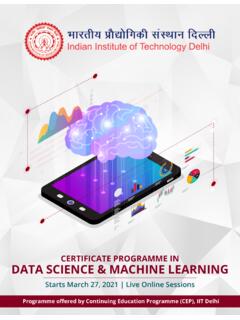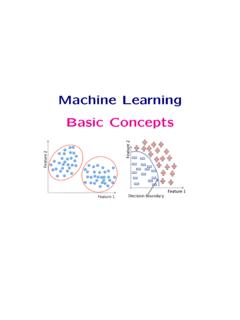Transcription of Machine Learning Yearning is a
1 Machine Learning Yearning is a project. 2018 Andrew Ng. All Rights Reserved. Page 2 Machine Learning Yearning -DraftAndrew Ng Table of Contents 1 Why Machine Learning Strategy 2 How to use this book to help your team 3 Prerequisites and Notation 4 Scale drives Machine Learning progress 5 Your development and test sets 6 Your dev and test sets should come from the same distribution 7 How large do the dev/test sets need to be? 8 Establish a single-number evaluation metric for your team to optimize 9 Optimizing and satisficing metrics 10 Having a dev set and metric speeds up iterations 11 When to change dev/test sets and metrics 12 Takeaways: Setting up development and test sets 13 Build your first system quickly, then iterate 14 Error analysis.
2 Look at dev set examples to evaluate ideas 15 Evaluating multiple ideas in parallel during error analysis 16 Cleaning up mislabeled dev and test set examples 17 If you have a large dev set, split it into two subsets, only one of which you look at 18 How big should the Eyeball and Blackbox dev sets be? 19 Takeaways: Basic error analysis 20 Bias and Variance: The two big sources of error 21 Examples of Bias and Variance 22 Comparing to the optimal error rate 23 Addressing Bias and Variance 24 Bias vs. Variance tradeoff 25 Techniques for reducing avoidable bias Page 3 Machine Learning Yearning -DraftAndrew Ng 26 Error analysis on the training set 27 Techniques for reducing variance 28 Diagnosing bias and variance: Learning curves 29 Plotting training error 30 Interpreting Learning curves: High bias 31 Interpreting Learning curves.
3 Other cases 32 Plotting Learning curves 33 Why we compare to human-level performance 34 How to define human-level performance 35 Surpassing human-level performance 36 When you should train and test on different distributions 37 How to decide whether to use all your data 38 How to decide whether to include inconsistent data 39 Weighting data 40 Generalizing from the training set to the dev set 41 Identifying Bias, Variance, and Data Mismatch Errors 42 Addressing data mismatch 43 Artificial data synthesis 44 The Optimization Verification test 45 General form of Optimization Verification test 46 Reinforcement Learning example 47 The rise of end-to-end Learning 48 More end-to-end Learning examples 49 Pros and cons of end-to-end Learning 50 Choosing pipeline components: Data availability 51 Choosing pipeline components.
4 Task simplicity Page 4 Machine Learning Yearning -DraftAndrew Ng 52 Directly Learning rich outputs 53 Error analysis by parts 54 Attributing error to one part 55 General case of error attribution 56 Error analysis by parts and comparison to human-level performance 57 Spotting a flawed ML pipeline 58 Building a superhero team - Get your teammates to read this Page 5 Machine Learning Yearning -DraftAndrew Ng 1 Why Machine Learning Strategy Machine Learning is the foundation of countless important applications, including web search, email anti-spam, speech recognition, product recommendations, and more.
5 I assume that you or your team is working on a Machine Learning application, and that you want to make rapid progress. This book will help you do so. Example: Building a cat picture startup Say you re building a startup that will provide an endless stream of cat pictures to cat lovers. You use a neural network to build a computer vision system for detecting cats in pictures. But tragically, your Learning algorithm s accuracy is not yet good enough. You are under tremendous pressure to improve your cat detector. What do you do? Your team has a lot of ideas, such as: Get more data: Collect more pictures of cats.
6 Collect a more diverse training set. For example, pictures of cats in unusual positions; cats with unusual coloration; pictures shot with a variety of camera settings; .. Train the algorithm longer, by running more gradient descent iterations. Try a bigger neural network, with more layers/hidden units/parameters. Page 6 Machine Learning Yearning -DraftAndrew Ng Try a smaller neural network. Try adding regularization (such as L2 regularization). Change the neural network architecture (activation function, number of hidden units, etc.) .. If you choose well among these possible directions, you ll build the leading cat picture platform, and lead your company to success.
7 If you choose poorly, you might waste months. How do you proceed? This book will tell you how. Most Machine Learning problems leave clues that tell you what s useful to try, and what s not useful to try. Learning to read those clues will save you months or years of development time. Page 7 Machine Learning Yearning -DraftAndrew Ng 2 How to use this book to help your team After finishing this book, you will have a deep understanding of how to set technical direction for a Machine Learning project. But your teammates might not understand why you re recommending a particular direction.
8 Perhaps you want your team to define a single-number evaluation metric, but they aren t convinced. How do you persuade them? That s why I made the chapters short: So that you can print them out and get your teammates to read just the 1-2 pages you need them to know. A few changes in prioritization can have a huge effect on your team s productivity. By helping your team with a few such changes, I hope that you can become the superhero of your team! Page 8 Machine Learning Yearning -DraftAndrew Ng 3 Prerequisites and Notation If you have taken a Machine Learning course such as my Machine Learning MOOC on Coursera, or if you have experience applying supervised Learning , you will be able to understand this text.
9 I assume you are familiar with supervised Learning : Learning a function that maps from x to y, using labeled training examples (x,y). Supervised Learning algorithms include linear regression, logistic regression, and neural networks. There are many forms of Machine Learning , but the majority of Machine Learning s practical value today comes from supervised Learning . I will frequently refer to neural networks (also known as deep Learning ). You ll only need a basic understanding of what they are to follow this text. If you are not familiar with the concepts mentioned here, watch the first three weeks of videos in the Machine Learning course on Coursera at Page 9 Machine Learning Yearning -DraftAndrew Ng 4 Scale drives Machine Learning progress Many of the ideas of deep Learning (neural networks) have been around for decades.
10 Why are these ideas taking off now? Two of the biggest drivers of recent progress have been: Data availability. People are now spending more time on digital devices (laptops, mobile devices). Their digital activities generate huge amounts of data that we can feed to our Learning algorithms. Computational scale. We started just a few years ago to be able to train neural networks that are big enough to take advantage of the huge datasets we now have. In detail, even as you accumulate more data, usually the performance of older Learning algorithms, such as logistic regression, plateaus.




